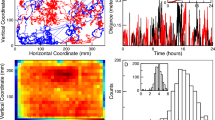Abstract
Traffic congestions have become a major problem in metropolitan areas world-wide, within and between cities, to an extent where they make driving and transportation times largely unpredictable. Due to the highly dynamic character of congestion building and dissolving this phenomenon appears even to resist a formal treatment. Static approaches, and even more their global management, have proven counterproductive in practice. Given the latest progress in VANET technology and the remarkable commercially driven efforts like in the European C2C consortium, or the VSC Project in the US, allow meanwhile to tackle various aspects of traffic regulation through VANET communication. In this paper we introduce a novel, completely decentralized multi-agent routing algorithm (termed BeeJamA) which we have derived from the foraging behavior of honey bees. It is highly dynamic, adaptive, robust, and scalable, and it allows for both avoiding congestions, and minimizing traveling times to individual destinations. Vehicle guidance is provided well ahead of every intersection, depending on the individual speeds. Thus strict deadlines are imposed on, and respected by, the BeeJamA algorithm. We report on extensive simulation experiments which show the superior performance of BeeJamA over conventional approaches.
Access this chapter
Tax calculation will be finalised at checkout
Purchases are for personal use only
Preview
Unable to display preview. Download preview PDF.
Similar content being viewed by others
6 Literatur
H. F. Wedde and M. Farooq. A Performance Evaluation Framework for Nature Inspired Routing Algorithms. In Proceedings of EvoComNet’05, Springer LNCS, March 2005.
H. F. Wedde, M. Farooq, and Y. Zhang. BeeHive: An Efficient Fault Tolerant Routing Algorithm Inspired by Honey Bee Behavior. In Proceedings of the ANTS 2004 Workshop, volume 3172. Springer LNCS, September 2004.
H. F. Wedde and M. Farooq. BeeHive — Routing Algorithms Inspired by Honey Bee Behavior. In Künstliche Intelligenz, (4): 18–24, Gesellschaft für Informatik e.V., 2005.
SFB 637, official homepage at: http://www.sfb637.uni-bremen.de
R. Barlovic, J. Esser, K. Froese, et. al. Online Traffic Simulation with Cellular Automata. In Proceedings of the FVU, Springer Heidelberg, 1999.
C2C Consortium, official homepage at: http://www.car2car.org
L. Neubert et. al. Statistical Analysis of Freeway Traffic. In Traffic and Granular Flow’ 99, Springer, 2000.
Ning, W. Verkehr auf Schnellstraßen im Fundamentaldiagramm — ein neues Modell und seine Anwendungen, University of Bochum, Internal Report 2000.
B. Tilch, D. Helbing. Evaluation of Single Vehicle Data in Dependance of Vehicle-Type, Lane and Site. In Traffic and Granular Flow’ 99, Springer, 2000.
M. Schreckenberg and K. Nagel. A Cellular Automaton Model for Freeway Traffic. J. Phys. I France 2, 2221. 1992.
M. Rickert. Simulation zweispurigen Verkehrsflusses auf der Basis zellularer Automaten. PhD Thesis, University of Cologne (Germany), 1994.
W. Knospe. Synchronized traffic: Microscopic Modeling and Emirical Observations. PhD Thesis, University of Duisburg (Germany), 2002.
U.S. Department of Transportation: Vehicle Safety Communications Project, online at: http://www-nrd.nhtsa.dot.gov
Author information
Authors and Affiliations
Editor information
Editors and Affiliations
Rights and permissions
Copyright information
© 2007 Springer-Verlag Berlin Heidelberg
About this paper
Cite this paper
Wedde, H.F. et al. (2007). Highly Dynamic and Adaptive Traffic Congestion Avoidance in Real-Time Inspired by Honey Bee Behavior. In: Holleczek, P., Vogel-Heuser, B. (eds) Mobilität und Echtzeit. Informatik aktuell. Springer, Berlin, Heidelberg. https://doi.org/10.1007/978-3-540-74837-3_3
Download citation
DOI: https://doi.org/10.1007/978-3-540-74837-3_3
Publisher Name: Springer, Berlin, Heidelberg
Print ISBN: 978-3-540-74836-6
Online ISBN: 978-3-540-74837-3
eBook Packages: Computer Science and Engineering (German Language)





